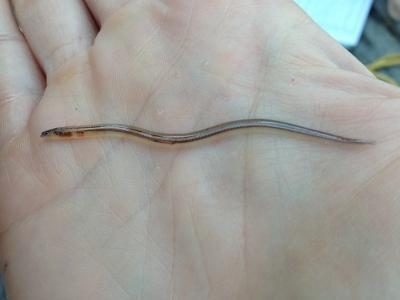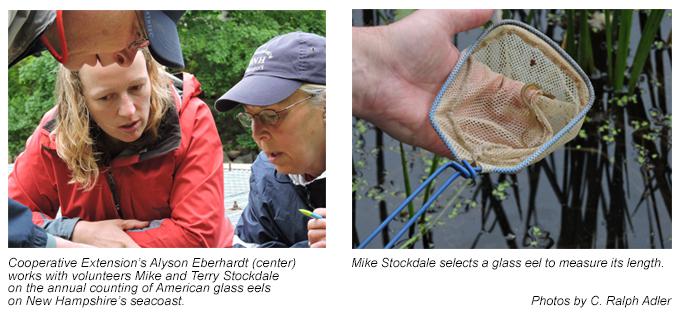Eels, Interrupted

Perched gingerly on the edge of a freshwater dam, Mike Stockdale dips his hand into a bucket teeming with writhing, four-inch long American glass eels. He delicately scoops out a few of these nearly transparent, slender, limbless fish—which, at this stage in their development, look like wiggly clear worms with two dark spots for eyes—using a small net. He silently counts them, then calls out the number. Sitting in a lawn chair on shore, Mike’s wife, Terry, marks the number down in a notebook. Mike continues the process—scooping, counting, scooping, counting—until they have a total for today’s catch—about 60.
Cooperative Extension’s Alyson Eberhardt, the third member of today’s eel counting team, monitors the work and answers questions as the two volunteers move from counting to measuring the length of a sample of the eels. Tenderly slipping a handful of the eels into another bucket containing clove oil, Mike lifts the now sleeping eels one by one onto a type of ruler that measures them in millimeters. Then the volunteers note the level of pigmentation of each glass eel on a scale of 1 to 7. Eels can have some color and still be glass eels, but when they are fully pigmented and less than 100mm, they are called elvers.
This work began in May and will continue on this New Hampshire river for about ten weeks, as Eberhardt and her team contribute to the annual counting the number of eels making their way from deep in the Sargasso Sea, 2,000 miles away in the heart of the Atlantic Ocean, to New Hampshire’s freshwater rivers and lakes, not unlike salmon who defy all odds to return to the fresh waters where they were spawned. While they exhibit just as much natural determination and sheer physical power, American eels work the opposite of salmon as they spawn in the salt water back in the seaweed-covered Sargasso Sea. In the thick of this year’s collection, in just this one New Hampshire site, the Cooperative Extension team counted between 6,000 and 7,000 glass eels fervently writhing their way up river each day, within two or three hours.
Eberbardt committed to this study last year as a way to help New Hampshire Fish and Game meet a requirement that the American eel population be monitored in at least two sites in each state every year. Previously, due to lack of personnel, Fish and Game could only monitor one site, which did not meet the standard set by Atlantic States Marine Fisheries Commission regulations. Now that Eberhardt and her volunteers have joined the annual monitoring, New Hampshire Fish and Game can met the commission’s expectations.
The eel count is one activity of many that goes into balancing the health of the eel population and the interests of fishermen who, worldwide, consider eels an important and lucrative catch.
“In some southeast Asian markets, eels, even at this age, can go for more than $3,000 a pound,” Eberhardt said. “They reached similar prices in Maine two years ago, the only state in New England with an eel fishery.” Eberhardt says that while eels continue to be among the most valued fish caught in seacoast-area waters, their value fluctuates significantly—this year, they have gone for somewhere more in the $500-$1,000 per pound range. And while local fisherman know where eels can be found, Eberhardt goes to some lengths to protect the location of the eel-counting site so that the fish can move upstream without being disturbed to spawn the next generations that will contribute to reasonable, balanced catches in the coming years.
In the thick of this year's count, Extension scientists and volunteers
counted more than 6,000 glass eels headed upriver within three hours.
The glass eels typically begin their run to fresh water in late April and early May. The Atlantic commission requires a six-week monitoring term but New Hampshire Fish and Game usually monitors for about 10 weeks for a more accurate count. “We are on the seventh week of this year’s count,” said Eberhardt, “and we’ll be out here five days a week.” It typically takes between one and three hours for Eberhardt and the volunteers to complete their daily assessment.
“Although Cooperative Extension receives no funding from N.H. Fish and Game for this project, Extension’s cadre of volunteers makes it possible to help out,” Eberhardt explained. “We’re helping Fish and Game with the amount and accuracy of data and in meeting its two-site requirement.” Eberhardt, a coastal ecosystems expert, decided to “sign up” as the count represents a major activity in the management of commercial fish species. She intends to continue participation next year and beyond as long as her time permits and volunteers come forth to assist.
Last year, Eberbardt took over and expanded Coastal Resource Volunteers (CRV) from Steve Jones at N.H. Fish and Game who started this collection of individuals—like the Stockdales—with specific interests in coastal resource management who make the commitment to Cooperative Extension to be available for activities like this one. More than 130 people currently belong to CRV, which has also become part of Extension’s Nature Groupie (formerly The Stewardship Network: New England) web site.
As Eberhardt and the Stockdales wrap up their count on this overcast, misty late spring morning, it’s clear that while their function is scientific, they are driven as much by affection for New Hampshire’s coastal resources and wildlife as by technical precision. Mike, a retired physical education teacher, probably knows how to keep a gym class of rambunctious high schoolers in line by being tough and loud when he had to. But as he allows a glass eel to wind itself around his finger, Mike’s motions in moving it to the ruler are gentle and respectful. Terry, also as a retired high school teacher (in her case, history), likely knows the value of discipline and sometimes taking a hard line, yet as she reminisces about the eel count and other volunteer efforts to which she has contributed on the New Hampshire coast, she speaks with the dedicated heart of a true steward of nature.
The annual eel count is one of those minor marvels of nature where the human race intersects with other forms of life, as hundreds of thousands of nearly invisible, slender fish are interrupted briefly, but importantly, to spend a few moments in the caring, careful hands of human beings watching out for the wellbeing of their species.
